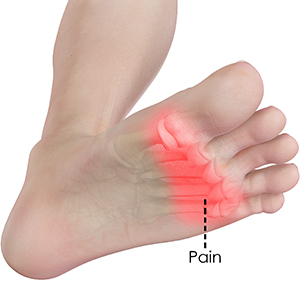Metatarsalgia

What is Metatarsalgia?
Metatarsalgia, also referred to as forefoot pain, is a type of pain that occurs in the ball of the foot (around the tip of the metatarsal bones). Generally, forefoot pain is associated with aging. Individuals with metatarsalgia experience pain of varied intensity and discomfort and find difficulty in activities such as walking, running and playing.
The forefoot is the anterior portion of the foot formed by five metatarsals, fourteen phalange bones, and various soft tissues. This complicated structure makes pain in this region more complex to diagnose.
What are the Symptoms of Forefoot Pain/Metatarsalgia?
Patients with metatarsalgia usually experience a sharp, aching or burning pain in the ball of the foot. The pain usually worsens during standing, walking, running or when the affected foot is flexed. Some may experience numbness or a tingling sensation in their toes. In most cases, the skin overlying the affected area becomes thick and hard, rough-textured, along with either complete/partial loss of sensation. This is often referred to as hyperkeratosis or callosity. Some people may notice changes in the shape of the feet or toes depending on the cause of pain.
What Causes Forefoot Pain/Metatarsalgia?
Because there are many causes of forefoot pain, it requires careful judgment to decide on the diagnosis and treatment plan. Some common causes include:
- Being overweight: Excess body weight tends to put more pressure on the metatarsal bones and cause pain.
- Overuse: Pain from overuse is often seen in athletes and runners.
- Shape of the foot: People with hammer toes (toe is bent at the middle joint) and bunions (a painful bump at the base of big toe) are also more prone to metatarsalgia.
- Big toe arthritis: Arthritis is an inflammation of the cartilage and lining of the bone joints. Osteoarthritis is the most common type which causes excessive trauma and wearing away of the cartilage in the joints of the big toe.
- Gout: This is a very common, painful form of arthritis which causes swelling, redness and stiffness of the joints. It usually affects the big toe and leads to severe pain.
- Stress fractures: Stress fractures of the foot which may occur in athletes or walkers can result in pain.
- Morton’s neuroma: This is a painful condition affecting one of the nerves between the toes (interdigital nerve). Morton’s neuroma refers to the thickening of the nerve tissue between your third and fourth toes due to scar tissue formation.
- Sesamoiditis: This condition is an inflammation of the sesamoid bones. These are the small, round bones embedded within the tendons leading to the big toe. The main cause of sesamoiditis is consistent pressure and tension applied over the foot. It is common in people who participate in potentially high intensity sports (runners) or jarring (jogging or boxing) activities.
- Pes cavus: This is a condition of a highly-arched foot shape. The gap between the sole of the foot and the floor is higher than normal and places excessive pressure on the balls of the feet.
- Loss of fat pad under the ball of the foot: With aging, the protective fat pad under the ball of the foot tends to thin out with overuse and may increase the susceptibility to pain in the ball of the foot.
- Poorly-fitting shoes: Wearing tight, narrowed or high-heeled shoes can put constant strain on the metatarsal bones causing forefoot pain.
How is Forefoot Pain Metatarsalgia Diagnosed?
A diagnosis must be cautiously made using a comprehensive history of the condition and direct questioning of the patient. Skilled knowledge of the forefoot anatomy allows a detailed examination and identification of the injured structure. Your surgeon may order X-rays or MRI of the affected foot or ankle to confirm the diagnosis.
What are the Treatment Options for Forefoot Pain/Metatarsalgia?
Early treatment is critical to relieve pain. Mild to moderate cases of forefoot pain can be managed by conservative treatment. Severe cases of neuroma and bunions may require surgery. The following conservative measures help to ease the pain of metatarsalgia:
- Medications: Your doctor may prescribe pain medications to reduce pain and inflammation.
- Resting your feet and applying ice packs wrapped in a towel over the sole of the affected foot can reduce pain and swelling.
- Adaptation to a weight loss dietary regimen, if you are overweight
- Activity modification: Avoid vigorous activities that exert excessive stress on bones and tendons of the feet. Begin specific exercises to help strengthen the foot muscles.
- Use customized orthotics or insoles to support and protect the foot. It also helps to cut back the pressure placed on the metatarsal bones.
- Toe pads, softening or gel pads can be placed inside your shoes to help cushion the shock while walking. Simple footwear modifications include using low-heeled shoes and broad toe box shoes with silicone gel pads to minimize discomfort at the tip of the toes.
- Immobilization using a cast, splint, brace, walking boot, or any other device to prevent movement of the feet and assist in faster healing of the ruptured tendon.
Surgery is considered as the last option if the symptoms fail to resolve with conservative treatment and depends on the age and activity level of the individual, extent of damage to the tendon or bone or nerve, and other factors.
Surgical treatment involves realigning or reshaping the metatarsal bones.
Related Topics
- Bunions
- Stiff Big Toe (Hallux Rigidus)
- Toe Deformities
- Arthritis of Foot
- Plantar Fasciitis
- Morton's Neuroma
- Flatfoot-Adult
- Foot Fractures
- Paediatric Foot Conditions
- Lisfranc (Midfoot) Injury
- Calcaneal Fractures (Heel Fractures)
- Bunionette (Tailor's Bunion)
- Metatarsalgia
- Toe and Forefoot Fractures
- Foot Rheumatoid Arthritis
- Sesamoiditis
- Athlete's Foot
- Foot Stress Fractures
- Cavus Foot Deformity




